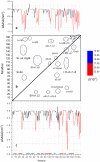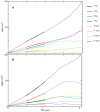Aggregation of lipid-anchored full-length H-Ras in lipid bilayers: simulations with the MARTINI force field
- PMID: 23923044
- PMCID: PMC3724741
- DOI: 10.1371/journal.pone.0071018
Aggregation of lipid-anchored full-length H-Ras in lipid bilayers: simulations with the MARTINI force field
Abstract
Lipid-anchored Ras oncoproteins assemble into transient, nano-sized substructures on the plasma membrane. These substructures, called nanoclusters, were proposed to be crucial for high-fidelity signal transmission in cells. However, the molecular basis of Ras nanoclustering is poorly understood. In this work, we used coarse-grained (CG) molecular dynamics simulations to investigate the molecular mechanism by which full-length H-ras proteins form nanoclusters in a model membrane. We chose two different conformations of H-ras that were proposed to represent the active and inactive state of the protein, and a domain-forming model bilayer made up of di16:0-PC (DPPC), di18:2-PC (DLiPC) and cholesterol. We found that, irrespective of the initial conformation, Ras molecules assembled into a single large aggregate. However, the two binding modes, which are characterized by the different orientation of the G-domain with respect to the membrane, differ in dynamics and organization during and after aggregation. Some of these differences involve regions of Ras that are important for effector/modulator binding, which may partly explain observed differences in the ability of active and inactive H-ras nanoclusters to recruit effectors. The simulations also revealed some limitations in the CG force field to study protein assembly in solution, which we discuss in the context of proposed potential avenues of improvement.
Conflict of interest statement
Figures






Similar articles
-
Organization, dynamics, and segregation of Ras nanoclusters in membrane domains.Proc Natl Acad Sci U S A. 2012 May 22;109(21):8097-102. doi: 10.1073/pnas.1200773109. Epub 2012 May 4. Proc Natl Acad Sci U S A. 2012. PMID: 22562795 Free PMC article.
-
Reversible Effects of Peptide Concentration and Lipid Composition on H-Ras Lipid Anchor Clustering.Biophys J. 2015 Dec 15;109(12):2467-2470. doi: 10.1016/j.bpj.2015.11.009. Biophys J. 2015. PMID: 26682805 Free PMC article.
-
Ras nanoclusters: molecular structure and assembly.Semin Cell Dev Biol. 2007 Oct;18(5):599-607. doi: 10.1016/j.semcdb.2007.08.003. Epub 2007 Aug 19. Semin Cell Dev Biol. 2007. PMID: 17897845 Free PMC article. Review.
-
DPPC-cholesterol phase diagram using coarse-grained Molecular Dynamics simulations.Biochim Biophys Acta. 2016 Nov;1858(11):2846-2857. doi: 10.1016/j.bbamem.2016.08.005. Epub 2016 Aug 13. Biochim Biophys Acta. 2016. PMID: 27526680
-
Mechanisms of Ras Membrane Organization and Signaling: Ras Rocks Again.Biomolecules. 2020 Nov 6;10(11):1522. doi: 10.3390/biom10111522. Biomolecules. 2020. PMID: 33172116 Free PMC article. Review.
Cited by
-
Geodesic curvature driven surface microdomain formation.J Comput Phys. 2017 Sep 15;345:260-274. doi: 10.1016/j.jcp.2017.05.029. Epub 2017 May 18. J Comput Phys. 2017. PMID: 28804159 Free PMC article.
-
Guardians of the Cell: State-of-the-Art of Membrane Proteins from a Computational Point-of-View.Methods Mol Biol. 2021;2315:3-28. doi: 10.1007/978-1-0716-1468-6_1. Methods Mol Biol. 2021. PMID: 34302667
-
Specific cancer-associated mutations in the switch III region of Ras increase tumorigenicity by nanocluster augmentation.Elife. 2015 Aug 14;4:e08905. doi: 10.7554/eLife.08905. Elife. 2015. PMID: 26274561 Free PMC article.
-
Spatiotemporal Analysis of K-Ras Plasma Membrane Interactions Reveals Multiple High Order Homo-oligomeric Complexes.J Am Chem Soc. 2017 Sep 27;139(38):13466-13475. doi: 10.1021/jacs.7b06292. Epub 2017 Sep 18. J Am Chem Soc. 2017. PMID: 28863262 Free PMC article.
-
Interactions of the EphA2 Kinase Domain with PIPs in Membranes: Implications for Receptor Function.Structure. 2018 Jul 3;26(7):1025-1034.e2. doi: 10.1016/j.str.2018.05.003. Epub 2018 Jun 7. Structure. 2018. PMID: 29887500 Free PMC article.
References
-
- Barbacid M (1987) ras Genes. Annual Review of Biochemistry 56: 779–827. - PubMed
-
- Wennerberg K, Rossman KL, Der CJ (2005) The Ras superfamily at a glance. Journal of Cell Science 118: 843–846. - PubMed
-
- Yan J, Roy S, Apolloni A, Lane A, Hancock JF (1998) Ras Isoforms Vary in Their Ability to Activate Raf-1 and Phosphoinositide 3-Kinase. Journal of Biological Chemistry 273: 24052–24056. - PubMed
-
- Voice JK, Klemke RL, Le A, Jackson JH (1999) Four Human Ras Homologs Differ in Their Abilities to Activate Raf-1, Induce Transformation, and Stimulate Cell Motility. Journal of Biological Chemistry 274: 17164–17170. - PubMed
Publication types
MeSH terms
Substances
Grants and funding
LinkOut - more resources
Full Text Sources
Other Literature Sources
Research Materials
Miscellaneous

